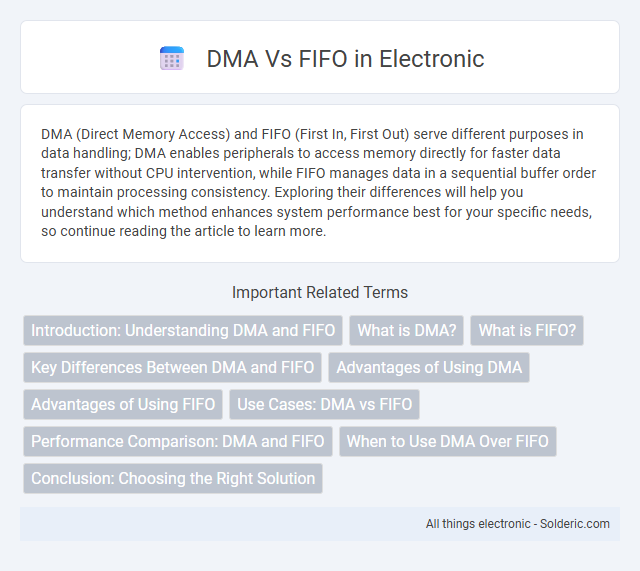DMA (Direct Memory Access) and FIFO (First In, First Out) serve different purposes in data handling; DMA enables peripherals to access memory directly for faster data transfer without CPU intervention, while FIFO manages data in a sequential buffer order to maintain processing consistency. Exploring their differences will help you understand which method enhances system performance best for your specific needs, so continue reading the article to learn more.
Comparison Table
| Feature | DMA (Direct Memory Access) | FIFO (First In, First Out) |
|---|---|---|
| Definition | Hardware feature allowing peripherals to access system memory directly without CPU intervention. | Data buffer or queue that processes data in the order it arrives. |
| Primary Purpose | Efficient data transfer between memory and peripherals. | Buffering data to maintain order and manage flow control. |
| Data Handling | Transfers bulk data autonomously. | Manages sequential data processing. |
| CPU Involvement | Minimal during transfer, offloads CPU. | CPU typically reads from or writes to FIFO. |
| Use Cases | High-speed data transfer (e.g., disk, audio, network). | Data buffering in streams, communication protocols. |
| Complexity | Higher hardware complexity and setup. | Simple data structure and easy implementation. |
| Latency | Lower latency for large data blocks. | Latency depends on queue length and read/write speed. |
Introduction: Understanding DMA and FIFO
DMA (Direct Memory Access) enables hardware devices to transfer data directly to or from memory without CPU intervention, enhancing system efficiency by reducing processor overhead. FIFO (First In, First Out) is a data buffering structure that processes data in the exact order it was received, ensuring sequential data flow and minimizing latency in communication systems. Implementing DMA with FIFO buffers optimizes data transfer by combining efficient memory access with orderly data handling.
What is DMA?
DMA (Direct Memory Access) allows hardware devices to transfer data directly to or from system memory without continuous CPU intervention, significantly improving data throughput and system efficiency. Unlike FIFO (First In, First Out) buffers that manage data order and temporary storage, DMA facilitates large block data transfers by bypassing the CPU, minimizing latency and freeing CPU resources for other tasks. Understanding how DMA operates can help optimize your system's performance, especially in applications requiring high-speed data handling.
What is FIFO?
FIFO (First-In, First-Out) is a data buffering technique that organizes data in the order it was received, ensuring the oldest data is processed first. It is commonly used in hardware and software systems to manage data flow efficiently, preventing data loss during transfer between devices or processes. Unlike DMA (Direct Memory Access), FIFO primarily focuses on sequential data handling rather than direct memory operations.
Key Differences Between DMA and FIFO
DMA (Direct Memory Access) allows peripherals to transfer data directly to or from memory without CPU intervention, optimizing speed and reducing processor load. FIFO (First In, First Out) is a buffer management technique that stores data sequentially and processes it in the order received, ensuring data integrity in streaming or real-time applications. Understanding these key differences can help you choose DMA for efficient bulk data transfers and FIFO for orderly data queuing in embedded systems.
Advantages of Using DMA
Direct Memory Access (DMA) offers significant advantages over FIFO by enabling high-speed data transfer directly between memory and peripherals without CPU intervention. This frees up the CPU for other tasks, reducing latency and improving system efficiency, particularly in real-time and high-throughput applications. DMA's ability to handle bulk data transfer minimizes bottlenecks caused by FIFO's sequential processing constraints.
Advantages of Using FIFO
FIFO (First-In-First-Out) buffers offer significant advantages in data management by ensuring orderly and predictable data processing, which reduces latency and minimizes data loss. Your system benefits from simpler implementation and lower CPU overhead compared to DMA, making FIFO ideal for applications requiring real-time data handling and steady data flow. The consistent data sequence maintained by FIFO enhances system reliability and simplifies troubleshooting in embedded systems and communication protocols.
Use Cases: DMA vs FIFO
DMA (Direct Memory Access) is primarily used in scenarios requiring high-speed data transfer between peripherals and memory without CPU intervention, such as audio/video streaming, disk access, and network data processing. FIFO (First In First Out) buffers excel in managing data flow in communication protocols and real-time processing systems where order preservation and smooth data handling are critical, like UART communication and sensor data acquisition. The choice between DMA and FIFO depends on the need for efficient bulk transfers (DMA) versus orderly queuing and buffering of data streams (FIFO).
Performance Comparison: DMA and FIFO
DMA offers superior performance by allowing direct memory access for data transfers, reducing CPU load and enabling faster data throughput compared to FIFO, which relies on CPU intervention for managing data flow. FIFO provides simpler buffering with predictable latency but can create bottlenecks under high data rates due to its dependence on the processor for handling each data unit. Your system's choice between DMA and FIFO should consider the required data transfer speed, CPU availability, and real-time processing demands to optimize overall performance.
When to Use DMA Over FIFO
Use DMA instead of FIFO when large volumes of data need to be transferred quickly and efficiently between memory and peripherals without burdening the CPU, such as in high-speed data acquisition or streaming applications. DMA excels in reducing CPU overhead by automating data movement, allowing the processor to perform other tasks concurrently. FIFO is more suitable for simpler, smaller data buffering scenarios where minimal latency and straightforward data handling are required.
Conclusion: Choosing the Right Solution
Selecting between DMA and FIFO hinges on system requirements, with DMA excelling in high-speed data transfer and efficient CPU utilization, while FIFO provides straightforward buffering for data flow management. DMA suits applications demanding minimal processor intervention and large data bursts, enhancing throughput in communication and multimedia systems. FIFO is ideal for simpler, lower-latency buffering needs where ease of implementation outweighs maximal transfer speed.
DMA vs FIFO Infographic

 solderic.com
solderic.com